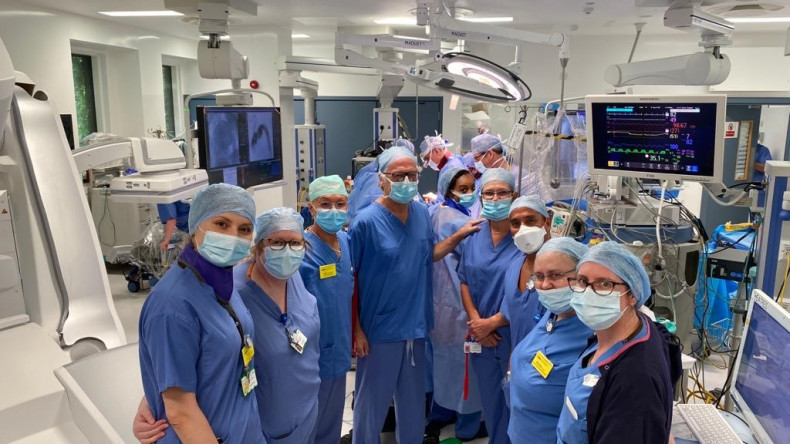Our cardiology team has performed a pioneering minimally invasive procedure to correct an aortic arch aneurysm using a custom-made stent, avoiding the need for open-heart surgery.

Professor Christoph Nienaber and his team
A silent condition with potentially fatal outcomes
An aortic arch aneurysm often develops slowly without symptoms but can lead to an aortic dissection if it becomes particularly large. Aortic dissections can be life-threatening and require emergency intervention, with chances of survival as low as 50% and patients aged 50-65 most at risk.
Lifestyle and medical treatments are the first line of therapy for an aortic arch aneurysm, but an elective surgical intervention may be recommended to prevent a dissection. Typically, this involves an open-heart procedure to replace all or part of the ascending aorta and a long hospital stay. Although the operative risk for this elective procedure is low and can greatly improve 5-year survival, it may not be suitable for high risk patients, such as those that are elderly.
A new minimally invasive approach
A 78-year-old patient was recently referred to our centre for an elective procedure to repair her aortic arch aneurysm. However, as she was in too frail a condition to perform a standard open-heart surgery, the cardiology team at Royal Brompton Hospital trialled a new minimally invasive endovascular approach to treat her.
The team, led by consultant interventional cardiologist Professor Christoph Nienaber and consultant cardiac surgeon Mr Ulrich Rosendahl, operated on the patient’s heart in the hospital’s state-of-the-art hybrid operating theatre – a traditional operating theatre but with the imaging capabilities of a catheter laboratory.
In the first stage of the surgery, consultant vascular surgeon Mr Maziar Mireskandari performed a ‘crossover bypass’ surgery, which is a procedure used to maintain blood flow to the patient’s brain and prevent a stroke – one of the main problems associated with keyhole surgery for the aorta.
In the second stage, two custom-sized Nexus™ stent components, were inserted into the aortic arch using keyhole surgery through the patient’s groin artery to repair the aneurysm and prevent dissection. The multi-part stents are custom prepared for each patient and inserted and fitted together within the aortic arch using imaging to guide the process. Due to the minimally invasive nature of the procedure, the patient was able to leave her bed very quickly and was discharged within a few days, with her recovery time reduced from several weeks.
Successful UK-first
Our team were the first to use this stent on a patient in the UK, and the first to treat an aneurysm encompassing the entire aortic arch by combining crossover bypass surgery with keyhole surgery.
Professor Nienaber said:
“We’re delighted that this combined procedure went so well and achieved such a terrific result for our patient. It took careful planning and was made possible through a highly skilled, multidisciplinary team, involving surgeons, anaesthetists, radiologists and cardiologists and lots of supportive team spirit.”
“We’re proud to be the first in the UK to complete this pioneering procedure and look forward to establishing this innovative technique at the Trust so more patients can benefit.”
 |
 |
 |
 |
The NexusTM Stent Graft System (top right) transforms a complex open-heart surgery to repair an aortic arch aneurysm (top left) into a standard minimally invasive endovascular procedure. The multi-part stent is customised to fit each individual patient optimally and is the first branched endovascular system to treat Aortic Arch Disease. A CT scan (bottom left) shows the patient’s aortic arch aneurysm before the procedure and a 3D CT scan (bottom right) shows the stent placed in the patient’s aortic arch.
To find out more about our minimally invasive techniques to repair an aortic arch aneurysm, or to refer a patient, please contact the customer services team on +44 (0)20 3131 0535 or email privatepatients@rbht.nhs.uk.
Contact us
For more information or to book an appointment, please contact our customer care team.


